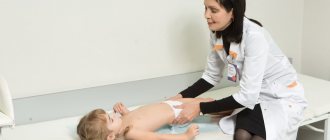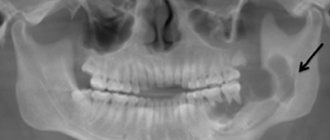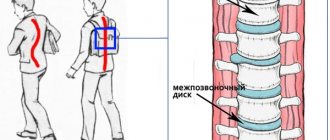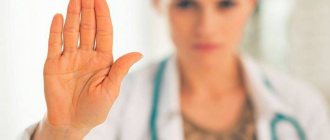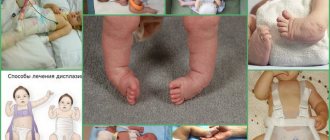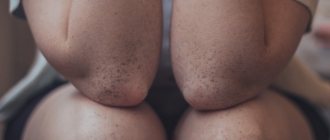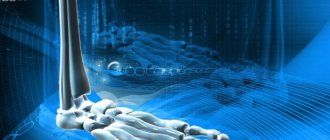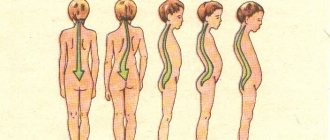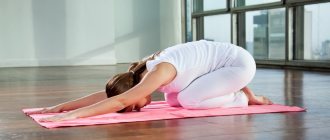Spine Pathology Center Dr. A.N. Baklanova successfully deals with conservative and surgical treatment of all types of childhood and adolescent scoliosis. We will answer all your questions by phone: +7 (499) 746 - 99 - 50. You can also ask a question by filling out the request form below.
Childhood scoliosis is an unnatural lateral flexion of the spine. The spine takes on an incorrect position, as a result of which a person’s movements are limited, internal organs are displaced, and disruptions in the functioning of the body occur. All this is accompanied by pain, the development of osteochondrosis, intervertebral hernias and other diseases. The danger of scoliosis is difficult to overestimate, since there is no drug treatment for this disease.
Types of scoliosis in children
According to the type of origin, scoliosis in children can be congenital or acquired . The causes of congenital disease are not related to heredity. Rather, this is the result of improper gestation of the fetus and the mother’s nutrition, when she took an insufficient amount of foods containing substances and minerals necessary for the formation of the child’s musculoskeletal system.
Acquired scoliosis is a consequence of improper development of the baby. The task of parents is to prevent the appearance of this disease, because in most cases it is a consequence of their carelessness. If scoliosis is not congenital, it is the result of the body constantly being in an incorrect position during infancy.
As a child grows, it is necessary to engage in physical development and avoid uncontrolled stress on the spine. It is especially important to develop muscles if it is noticed that the muscular spinal corset is not developed and weak. Injuries can trigger the onset of scoliosis.
According to the type of manifestation of the disease, scoliosis can be left or right-sided with one, two or three arcs of deformation . It manifests itself in the neck, neck and chest, in the chest, thoracolumbar part, in the lower back, and also combines elements of several curvatures.
The importance of physical therapy for scoliosis
Therapeutic exercise is used for the prevention and treatment of the disease in the first and second stages of its development. In the later period, it becomes an additional, but not the main way to combat the disease. It includes a set of special movements aimed at strengthening the spinal muscles. The effectiveness of exercise therapy increases if it is carried out under the supervision of parents, since the trainer during the lesson cannot pay constant attention to all students.
Physical therapy is a classic remedy for overcoming illness. In most cases, it helps to stop its flow and return the spine to its correct position. Therefore, it is important to immediately begin treatment for childhood scoliosis as soon as its symptoms are identified.
Surgical intervention is an extreme and complex measure, which should be resorted to in cases dangerous to health. It is easier to prevent and cure a disease through exercise therapy than to complicate the problem.
For children with special needs, physical therapy (PT) helps them develop properly and recover from illnesses or injuries. Even if there are no medical indications, exercise therapy is very useful for children of any age. They are all spontaneous and inquisitive, constantly on the move. The body develops, systems and organs are formed. It is important not only to play and talk with the child, but also to develop physically - to do gymnastics.
Exercise therapy for children is part of a program of prevention and treatment, rehabilitation after illness. This is not a drug, but an effective method of influencing the child’s body. As a rule, it is prescribed by a pediatrician or specialist according to the indications, age, condition and characteristics of the child’s body.
Classes can be in a group, individual or even at home. To make it interesting for children, the instructor organizes the lesson in a fun, playful way. To conduct classes at home, parents learn exercise therapy techniques in order to practice daily without interrupting the course.
Physical therapy for children is prescribed for the following diseases:
- Pneumonia;
- Congenital torticollis;
- Hip dysplasia;
- Rheumatism;
- Bronchial asthma;
- Poor posture;
- Flat feet;
- Clubfoot;
- Rickets;
- Cerebral palsy.
It is important to start a complex of exercise therapy in childhood. If the disease is not treated, the child will lag behind in development, and functional disorders may appear. After a course of exercise therapy, metabolism improves, deformation of the musculoskeletal system, and retardation in growth and development are prevented. Correct technique and timely measures can both improve the prognosis and cancel the diagnosis.
Exercise therapy for children has distinctive features. General – a large number of game exercises. Programs depend on age, diagnosis, and also take into account the child’s level of development, mental characteristics and motor skills.
Differences in exercise therapy for children of different ages
Children under one year old
For a child in his first year of life, exercise therapy is more important than for an adult. Physical education has a beneficial effect on the physical and mental state of children. Thanks to regular classes, children’s motor and speech skills are formed in a timely manner and develop correctly.
Physical therapy classes are necessary for premature babies, also sedentary, with decreased appetite, nervously excitable, and after illnesses. But therapeutic exercises are more indicated for children with disabilities in physical or mental development.
- Exercise therapy for children in the first year of life consists of reflexive, passive and active exercises. These movements that a child makes in response to external irritation are called reflex exercises. These movements are unconscious. If a specialist working with a child does exercises for him, then such exercises are called passive. And if he does it himself, do active exercises. Exercise therapy is often complemented by massage for children.
- At the age of 1.5 to 3 months, children are distinguished by increased muscle tone, and they also exhibit innate reflexes. Therefore, at this age it is recommended to use only reflex exercises.
- In children from 3 to 4 months, a balance in the tone of the flexor and extensor muscles of the arms is established. It is recommended to focus on passive exercises for infants.
- During the period of 4 to 5 months, the child develops muscle tone in the legs and neck. There are specific exercises for this age.
- A child between 6 and 9 months develops voluntary movements. Therefore, the complex of physical education classes includes active exercises that encourage crawling, sitting and standing.
- Between the ages of 9 and 12 months, coordinated movements develop, as does the desire to walk. Exercise therapy is aimed at developing and consolidating these skills.
Exercise therapy for preschool children
This period is characterized by the fact that motor skills have not yet been fully formed.
Why does sitting or standing for a long time, incorrect posture, as well as furniture that is not appropriate for the child’s age, adversely affect the formation of the skeleton. And often lead to poor posture. Therapeutic exercises have a positive effect on the respiratory, cardiovascular and autonomic systems. It also helps strengthen the immune system, enhance the body’s performance and endurance. At the age of 5 to 7 years, regular exercise therapy courses will help prepare for school stress, help avoid overwork and cope with stress.
Gymnastics for school-age children
Exercise therapy includes exercises for the general development and strengthening of a young body. You need to exercise regularly. Physical exercise improves the functioning of vital body systems: cardiovascular, respiratory and nervous. The musculoskeletal system is strengthened, metabolic processes are improved.
In children of primary school age, the musculoskeletal system is not yet fully formed. The body has great mobility and flexibility. Due to prolonged sitting at a desk and studying at home, poor posture occurs. And physical therapy helps strengthen muscles, and also trains individual muscles and joints, and develops correct posture. Exercise therapy for children of primary school age takes the form of a game. The complex includes formations, exercises with balls and hoops, climbing, jumping, running, balance exercises, as well as dance and acrobatic exercises.
Middle school students are already starting puberty. The skeletal system is actively growing, muscle tissue often cannot keep up with it. The child gets tired quickly from minor physical exertion. There may be a lack of coordination of movements. Therefore, exercise therapy for children of middle school age includes more complex exercises, which are different for girls and boys. For girls, they include elements of rhythmic gymnastics, and for boys, strength exercises using sports equipment and equipment. Due to the workload at school, adolescents experience a sharp decrease in physical activity. And scheduled physical education lessons are not enough. And at this age, due to the formation of the motor analyzer, the child’s need for movement increases. Due to a sedentary lifestyle and excess nutrition, the risk of obesity increases. This is dangerous for the development of diseases that will affect the quality of life in the future.
Features of high school age
In children of senior school age, the process of body formation is almost complete. Exercise therapy is aimed at preparing young people for the stress of adult life.
When selecting exercises, the main thing is to take into account the child’s health level. Children with diseases of the cardiovascular and respiratory systems need to select special complexes, after which the functioning of the heart and circulatory or respiratory organs is normalized. Such activities support the child’s body and prevent complications. From the necessary exercises, a complex of exercise therapy for children is compiled. Gymnastic exercises should be performed in special sportswear and shoes. After doing gymnastics, you need to take a shower to cleanse your body of sweat and other waste products.
Exercise therapy for various diseases in children
Congenital muscular torticollis
Often the main cause of congenital muscular torticollis is underdevelopment of the sternocleidomastoid muscle. As well as her injury during childbirth or birth injury to the cervical spine. With pathology, the head is tilted towards the affected muscle, turned in the opposite direction and tilted back. With severe torticollis, the shoulder girdle and scapula on the affected side are higher, and the back of the head on the healthy side is often slanted. The consequences of this curvature are quite serious. As a secondary sign of the disease, facial asymmetry may appear. With moderate and severe degrees of congenital muscular torticollis, the child may have a delay in psychomotor development.
Treatment of congenital muscular torticollis should begin as early as possible, from the age of 2-3 weeks. Massage plays the main role, and a general strengthening complex of exercise therapy is part of the therapy for muscular torticollis. The complex prescribed by the doctor corresponds to the age and development of the child. Therapeutic exercises for congenital muscular torticollis can completely restore the function of the operated muscle, when correction of torticollis by massage and exercise therapy for infantile torticollis is impossible. To do this, the exercises use head movements with resistance and weights in different positions. And also exercise therapy for muscular torticollis in this period includes exercises aimed at correcting posture.
A course of exercise therapy for congenital muscular torticollis consists of 15-20 sessions. They are carried out every day or every other day, the break between courses is 1-1.5 months. During intervals, home exercises are necessary. During the first year of life, the child must undergo 3-4 courses of complex therapy, and then another 2-3 courses until the age of 7. Home exercises are required daily for 5–15 minutes up to 2 years. Children with torticollis are advised to exercise in the pool from an early age, for example, aqua gymnastics with a water temperature of 35-36 degrees.
For flat feet
Regular exercise therapy can help prevent the development of flat feet. This will form a healthy foot. If your child already has flat feet, you should not treat it yourself. A course of exercise therapy for the prevention and treatment of flat feet should be prescribed by an orthopedist.
Therapeutic gymnastics for children’s flat feet is selected taking into account the child’s physical fitness, age, shape and period of the disease. For each age, treatment includes physical exercises that strengthen the body, as well as special physical exercises and massage that relieve pain. And also physical exercises with and without equipment, aimed at strengthening the muscles that support the arches of the feet and the formation of the depth of the arches. General strengthening physical exercises for children's flat feet should not overload the musculo-ligamentous apparatus of the feet. Sports that put a dynamic load on the feet are recommended: crawl swimming, skiing, ball sports. Sports should be carried out under the supervision of a doctor in order to comply with the principle of gradually increasing the load.
Therapeutic exercises for flat feet in children include: adduction of the foot, turning it inward, dorsiflexion of the foot, sliding movements of the foot of one leg along the shin of the other, picking up small objects with the toes, spreading and sliding the toes, rolling a small ball, squatting on a transversely lying stick. Exercise therapy is best done in a playful way: walking on a rolling pin, reaching for objects with your feet, climbing a wall bars.
Treatment of flat feet in children should begin at an early age. You can achieve results at an older age, but it is better not to postpone a course of exercise therapy for flat feet in a child. The set of exercises must be repeated regularly.
For clubfoot
The main signs are: internal rotation of the sole with raising the inner edge of the foot and lowering the outer edge, adduction of the foot in the forefoot, plantar flexion, significant limitation of mobility in the ankle joint. Clubfoot in children has two types: clubfoot equinovarus - when the heel is displaced inward and clubfoot valgus - the heel is displaced outward. Therapeutic gymnastics for clubfoot in children consists of a gradual gentle correction of the vicious position of the foot. Exercises should be combined with massage and performed gently so that the child experiences pain. A good effect is achieved when therapeutic exercises for clubfoot in children are carried out after thermal procedures.
And parents can also carry out a set of exercises at home for clubfoot in children and gradually increase the load. A physical therapy specialist will give recommendations on which exercises are useful in a particular case. You should also include exercises to stretch the spine. Thanks to them, the back is unloaded. It is important to organize the child’s daily routine so that therapeutic exercises and swimming are given a separate place. No matter what the cause of clubfoot is, children need to exercise regularly. This is also the prevention of clubfoot in children. If the treatment tactics are chosen correctly and all the orthopedist’s recommendations are followed, then the pathological deformation of the foot can be completely eliminated.
Is it possible to do exercise therapy on your own?
For schoolchildren, exercise therapy with a qualified doctor is better suited. The doctor will combine exercise therapy with massage of the calf muscles and foot muscles, and will supplement with a course of physiotherapy if necessary. All this will help to achieve significant improvements in the treatment of flat feet.
Exercise therapy for flat feet in children should be carried out twice a day: an hour and a half before bedtime or an hour after meals. The duration of the exercises is 15 minutes. If classes are conducted at home, they should be regular and with increasing load. The goal is to develop and strengthen the muscles of the fingers, foot and lower leg. Exercises for flat feet in children should be supervised by parents, and, if possible, by a physical therapy instructor. Overwork and pain are unacceptable. Because this indicates additional muscle tension in the child.
Physical therapy for a child should bring joy and pleasure, and not be done by force. Make sure that the child is motivated to achieve the results of the lessons. Explain why the exercise therapy complex is needed, what can be achieved, how important it is. Don't forget to tell him that you love him and want him to become healthy. Before exercising, consult your doctor. It is necessary to take into account individual characteristics and only then engage in physical therapy.
A set of exercises for scoliosis
Back exercises can be performed in any conditions. Walking is recommended for warming up. It is important that your posture is straight. It helps to stretch the body up and lift it onto your toes.
Exercises in a vertical position:
- Hands clasped in fingers, raised up, swinging the body to the sides.
- Bend to the sides while simultaneously pulling the arm opposite the tilt to the shoulder along the body.
- One hand is raised up. At the same time, alternating movements are made with the upper and lower arms moving back.
- One arm is raised directly above the head, a bend is made while simultaneously moving the second arm behind the back. The repetitions are done symmetrically.
- When standing against the wall, you need to hold on to the support and move your body to the side, observing the correct sequence.
- Kneeling, hands are fixed on the belt. One arm goes up, the body leans in the opposite direction.
Lying on your stomach:
- The arms and legs are spread to the sides, the body bends backward as much as possible.
- Hands forward. As the torso rises, the right or left leg rises alternately.
- Hands in front, holding a stick. By bending, the upper body and arms rise.
- Crawling with alternately pulling forward the arm and the leg opposite to it.
Kneeling and sitting exercises:
- Standing on all fours, the arm reaches up at the same time as the opposite leg. After returning to the starting position, alternate repetitions.
- Rotations of the torso, standing on all fours with the arm moving in the opposite direction.
- Kneeling and leaning on your hands, the body smoothly moves forward and returns back.
- Sitting with your legs bent under you, your arm stretches upward, your body bends, and the leg opposite your arm extends to the side. Return to original position. Repeat with stretching in the other direction.
- On the edge of the chair. One hand is on the belt, the other is behind the head.
- The position is the same, but tilts are made.
Rest by lying on your back with your arms extended along your body.
An integral part of exercise therapy is swimming. This is a powerful tool in the fight against scoliosis. If this sport is not contraindicated, a doctor will definitely prescribe it as one of the elements of a conservative treatment method. An additional advantage of swimming is that it is not a risky sport. The muscles are stretched and strengthened smoothly and evenly. The mobility of joints and muscles increases, the child gets used to force loads that do not put pressure on the spine. When swimming, the level of sugar and cholesterol in the blood decreases, and the problem of metabolism is eliminated.
Prevention of scoliosis in children
Prevention of scoliosis in children begins with the care of parents even before they are born. It is important that a pregnant woman eats foods that contain the full range of vitamins and minerals needed for the baby's development. Bones and muscles must constantly develop, and freedom of movement is best for this.
It is important to ensure that the child sleeps in the correct natural position.
You cannot send a child to school earlier than is allowed at his age. It’s right when he starts to sit up on his own, but it’s important that the baby doesn’t get overtired. The correct sitting position is when the child independently holds his body without leaning on a pillow. The child should eat, play with toys, and draw at a table that matches his height and in the correct position.
Exercises to strengthen the child’s back and massage
Anatomy in necessary matters
Currently, there is a test that determines the condition of a child’s back, according to his age:
- trapezius muscle. It is responsible not only for the displacement of the shoulder blades themselves, the child can make head movements;
- the latissimus muscle, the action of which is to bring the torso closer to the limbs and allows you to control the movement of the arms;
- a muscle responsible for straightening the spine.
How to prepare for classes?
We start when the baby reaches six months. To carry out this procedure, you need to place the baby on his tummy, then gently lift him and hold him where the waist is.
In normal condition, the child’s back is in the “swallow” position. This way you can determine how much your back muscles need strengthening.
We begin training after determining muscle development and the general state of muscle strength in the baby. At the same time, we pay attention to the results of the training itself and celebrate the achievements after the exercises.
Complex training
There is a set of exercises that help strengthen the back of infants. Strengthening a child’s back should be done while he is in the arms of an adult. During this procedure, the baby should be turned with his back to the adult, who is supporting the child under the bottom. At the same time, you can support the baby, straighten up, and lean forward.
This exercise allows the baby to learn to hold himself vertically with his upper body. We do this exercise for the child several times a day, always monitoring the position of the body.
1. A gymnastics ball is an excellent exercise tool that promotes muscle development. How can you strengthen your back with an exercise ball? To do this, you need to put the baby on his tummy. In this case, the position of the legs should be towards an adult. From the very beginning of training, we hold the child under the arms.
Movements should be of a rolling nature, which imply exercises of directed action, both towards oneself and away from oneself. This exercise allows the baby to learn to arch his back in a “boat” manner.
The intensity of the exercises should be moderate so that the load is not too strong. The number of exercises should not exceed 3-4 times. After completing these exercises, you can change the direction of the movement used, turning the baby clockwise or counterclockwise.
2. After using the above exercises, which the child will be able to do easily, you can move on to using more complex workouts. More complex exercises involve holding the baby by the hips, and not under the arms, as was done before.
Thanks to this exercise, the baby will be able to learn how to stay on the canopy. By gradually training your baby, this time will increase noticeably.
The importance of massage in the development of a child in the first year of life
In addition to gymnastic exercises that allow for future treatment of posture and strengthen the baby’s muscles, there is a special back massage designed specifically for children. These exercises need to be used as children at six months of age begin to strive to learn to sit independently. That is why it is so important that at six months the baby shows diligence and can support his back independently. This will be an excellent preventive measure against various curvatures of the spine and will provide significant assistance in distributing physical activity, provided that it is distributed over your entire skeleton.
Massage for a child of the first year of life
It is important and even necessary to massage your child if you want to strengthen the baby’s muscle corset. At the same time, we lay the baby on his tummy. The child's feet should be positioned towards the adult.
The exercises are carried out in several stages:
- The essence of stroking is that you need to make movements with your hands directed upward, by analogy - downward, then along the entire spine. Stroking occurs in the direction from the spine to the side towards the ribs with the pads of the fingers.
- Using movements reminiscent of small spirals, which we carry out with our fingertips, we rub that area of the back, along the spine.
- And finally, kneading. One of the final stages in which we stretch the back muscles.
Author: K.M.N., Academician of the Russian Academy of Medical Sciences M.A. Bobyr
